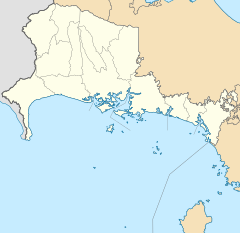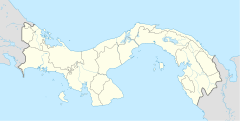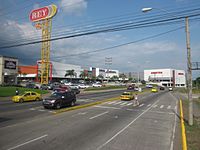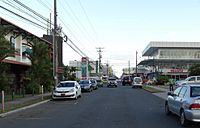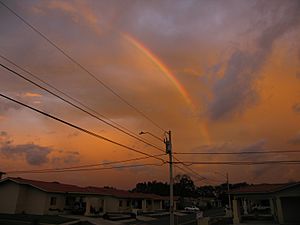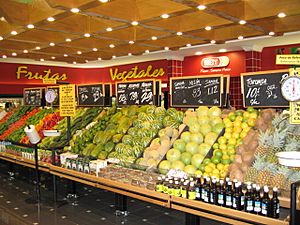David, Chiriquí facts for kids
Quick facts for kids
David
Ciudad de David
|
||
|---|---|---|
| City of David | ||
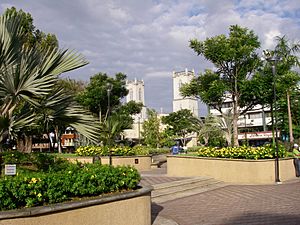
Main square with church
|
||
|
||
| Country | ||
| Province | Chiriquí | |
| District | David District | |
| Founded | 1602 | |
| Founded by | Juan Lopez de Sequeira | |
| Area | ||
| • Total | 176 km2 (68 sq mi) | |
| Elevation | −6 m (−19.7 ft) | |
| Population
(2013)
|
||
| • Total | 82,907 | |
| • Density | 471.1/km2 (1,220/sq mi) | |
| Languages = Spanish | ||
| Demonym(s) | Davidian | |
| Time zone | UTC−5 (EDT) | |
| Climate | Am | |
| Human Development Index = 0.890 | ||
David (pronounced da-VEED), also known as David City in the past, is a lively city in western Panama. It is the capital of the Chiriquí Province. In 2013, about 82,907 people lived there. David is a well-off city with many middle-class families. It has very low unemployment and poverty. The Pan-American Highway is a main road that leads to David. The city is named after the famous King David from the Bible. It is the biggest city in Panama outside of the Panama City area.
David is growing fast! Its economy is boosted by banks, new buildings, and more businesses. For example, the airport is getting bigger, and the road to Boquete is being improved. The city is the main economic hub for the Chiriquí province. It creates more than half of the province's total economic output. David is known for being the third-largest city in Panama by both population and economic activity. It is also the biggest city in Western Panama.
Contents
History of David
David was founded in 1602 by Governor Juan López de Siqueira. The city first started where Bolivar Park is today. Back then, the city was split into three parts. One part was for Spanish residents, and two smaller areas were called "San Antonio de Padra," "David," and "Nuestra Señora del Rosario." By the late 1800s, David had six streets, but only four were busy. These made up the city center, now called Barrio Bolívar. The San José Cathedral was also in this area. In March 1900, Bolivar Park was where the first battle of the "Thousand Days' War" happened. This was a big fight between different political groups in Panama.
For a while, the main government did not officially recognize David as a city. However, important people lived there. Juan Lopez de Sequeira is seen as a key thinker for the city. Francisco de Gama is also credited with helping to create it. In 1736, the city finally got official recognition from the colonial government. It was then named "La Ermita San Jose de David."
From 1916 to 1949, the Chiriqui province had a railway system. This railway was built to help the province grow and move farm products. The 165-kilometer-long railway had its main stations in David. This made David an even more important trading city for western Panama.
Old documents say that the local native people suggested the city's name. David was also a resting spot on the "Camino Real," or "Royal Trail." This long trail connected the rest of Central America with Panama City.
The city's airport is called Enrique Malek International Airport. During World War II, it was known as David Field or San Jose Field. It helped defend the Panama Canal. Many United States Army Air Forces planes used it for training and looking for threats. They patrolled the Pacific coastline from Honduras to Peru.
Education in David
David is home to several universities, offering many learning opportunities.
Universities
- Universidad Autónoma de Chiriquí
- Universidad Santa Maria La Antigua
- Universidad Tecnologica de Chiriquí
- ULACIT Chiriquí
- Columbus University
International Schools
- American School
Commerce and Industry
San José de David is Panama's third-largest city area. It is a central place for business in the province. This includes agriculture (farming) and cattle raising. David supplies many goods to the rest of Panama. It is also the main financial center for the region. Many national and international banks have offices here.
David is also a port for sending and receiving goods from nearby Costa Rica. The Pan-American Highway and the Enrique Malek International Airport connect it to the rest of the country. David is one of Panama's most industrialized cities. It is a center for manufacturing, heavy industry, and modern communications. The city is also a popular place for tourists. People enjoy its nightlife, entertainment, delicious cuisine, and shopping. It is also close to the Pacific coast and the cool Panamanian highlands.
Location and Geography
David is located in a flat area in the south-central part of Chiriquí Province. It sits between the coastal city of Puerto Armuelles and the mountain town of Boquete. The city is near the David River, at the base of the Cordillera de Talamanca mountains. From the northern parts of the city, you can see Volcán Barú. This is a volcano that could become active, and it is also the tallest mountain in Panama. David is about 30 kilometers (19 miles) from the border with Costa Rica. It is a very important place for trade between the two countries. Panama City is about 434 kilometers (270 miles) away.
The city itself does not have many big hills or mountains. The main natural landmarks are "Cerro San Cristobal" and "Cerro Pedregal." These are located in the southern part of the city, in the Pedregal area. To the north of David, you can see "Cerro Santa Cruz" and "Pico de Loro" (which means "Parrot's Peak").
The Manjagua and David rivers flow around the northeast of David. They separate David from the residential area called "Las Lomas." There are also smaller rivers that flow south. These rivers feed into the Pedregal estuary, which surrounds Pedregal. This estuary reaches the sea near the Enrique Malek International Airport.
The ocean coast near David has many beaches and mangrove forests. The city's main port, Pedregal, is in the southern part of the city, close to the mangroves. The port is also connected by land to the airport. This port is where small private boats and yachts dock. It is also a popular spot for fishing. From here, you can take tours to the many islands in the Chiriquí Gulf. Many people who sell handmade crafts also work here.
The city is also where the main church office for the Roman Catholic Diocese of David is located.
Climate in David
David has one of the hottest climates in Central America. However, temperatures drop quite a bit as you go to the city's edges. David's climate is known as a tropical monsoon climate. This means it has a short, very hot, dry season from mid-December to mid-April. Then, it has a long, hot, and rainy season from mid-April to mid-December.
| Climate data for David, Chiriquí | |||||||||||||
|---|---|---|---|---|---|---|---|---|---|---|---|---|---|
| Month | Jan | Feb | Mar | Apr | May | Jun | Jul | Aug | Sep | Oct | Nov | Dec | Year |
| Mean daily maximum °C (°F) | 32.2 (90.0) |
33.3 (91.9) |
33.9 (93.0) |
33.3 (91.9) |
31.7 (89.1) |
31.1 (88.0) |
30.6 (87.1) |
30.6 (87.1) |
30.6 (87.1) |
30.0 (86.0) |
30.0 (86.0) |
31.1 (88.0) |
31.5 (88.7) |
| Mean daily minimum °C (°F) | 21.7 (71.1) |
22.2 (72.0) |
22.8 (73.0) |
23.3 (73.9) |
23.3 (73.9) |
23.3 (73.9) |
23.3 (73.9) |
22.8 (73.0) |
22.8 (73.0) |
22.8 (73.0) |
22.8 (73.0) |
22.2 (72.0) |
22.8 (73.0) |
| Average rainfall mm (inches) | 33.3 (1.31) |
19.3 (0.76) |
35.5 (1.40) |
102.5 (4.04) |
297.0 (11.69) |
322.6 (12.70) |
289.8 (11.41) |
340.3 (13.40) |
406.6 (16.01) |
400.5 (15.77) |
295.4 (11.63) |
77.4 (3.05) |
2,620.2 (103.17) |
| Average relative humidity (%) | 67.7 | 62.6 | 62.4 | 69.6 | 79.5 | 81.1 | 80.4 | 81.1 | 82.1 | 83.8 | 82.8 | 75.5 | 75.7 |
| Mean monthly sunshine hours | 275.5 | 262.0 | 270.5 | 216.2 | 160.4 | 128.3 | 141.1 | 148.6 | 135.4 | 139.5 | 154.5 | 218.7 | 2,250.7 |
| Source 1: World Meteorological Organisation (UN) (30 yr record), | |||||||||||||
| Source 2: ETESA (humidity and sun values) | |||||||||||||
City Layout
The center of David is mostly set up in a grid, with streets having numbers. However, streets on the edges of the city do not have names or numbers. David does not have a very high population density. Most people live in their own single-family homes. Most buildings in the city, even in the main business area, are only one or two stories tall. Only a few hotels, banks, casinos, and apartment buildings are taller, reaching two to five stories.
Many people from other countries and the wealthiest residents live in the northern part of the city. They also live in the nearby towns just north and northwest of David. This area is also a business district. It has many popular stores and shops.
David has many places to stay. As the Chiriquí province becomes more popular for tourists, more hotels are being built. These hotels offer different amenities and prices to fit all budgets. The hotels are in the city center, close to the banking and business areas. This gives them a very central location. Many backpackers and travelers on a budget have recently discovered David. There are two main hostels for backpackers: Bambu Hostel and Purple House. The area is also home to the Miguel de Cervantes Saavedra Park. This central location is where many of Chiriqui's main businesses and banks operate from.
Miguel de Cervantes Saavedra Park is right in the middle of the city. This park is a nice place for visitors and locals to rest while walking through the city. It is known for its trees, which offer shade from David's usually sunny weather. You can find people selling ice cream, handmade crafts, and lottery tickets there. The park is surrounded by banks, hotels, and many shops.
Notable Residents
- Gonzalo Brenes - a composer, music expert, politician, and music teacher
- José Luis Lacunza Maestrojuán - a Cardinal of Panama (a high-ranking church official)
- Carlos Ruiz - a baseball player, known for playing with the Philadelphia Phillies
- Rosa Montezuma - a fashion model and Señorita Panamá 2018 (a beauty pageant winner)
See also
 In Spanish: David (ciudad) para niños
In Spanish: David (ciudad) para niños



